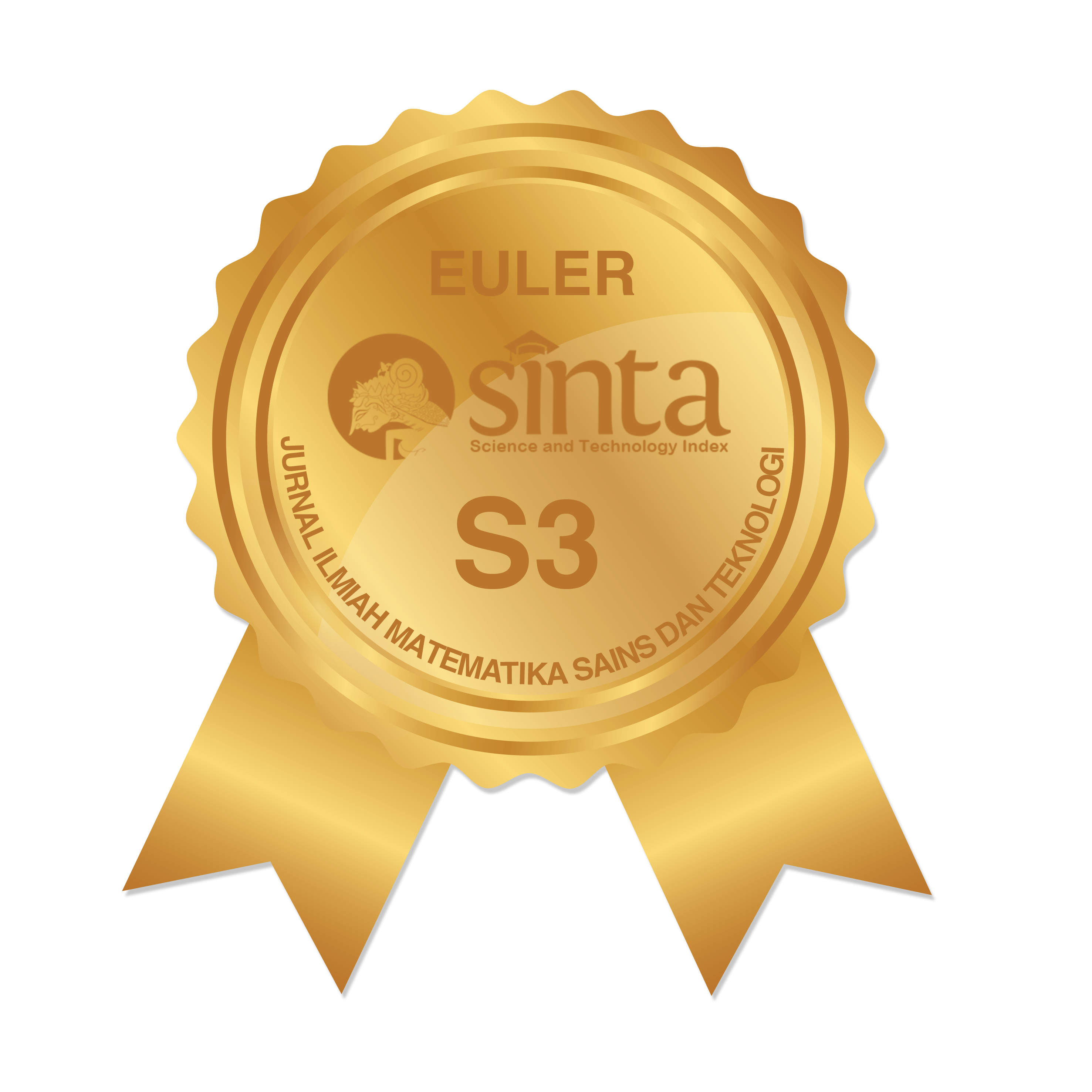Model Matematika Optimasi Multi-Objektif Penurunan Beban Limbah Biochemical Oxygen Demand pada Instalasi Pengolahan Air Limbah
Abstract
Keywords
Full Text:
PDFReferences
D. Mara, Domestic wastewater treatment in developing countries. UK: Earthscan, 2004.
W. B. Suyasa, Pencemaran Air dan Pengolahan Air Limbah. Bali: Udayana University Press, 2015.
R. C. Umaly and L. A. Cuvin, Limnology: Laboratory and field guide psyco-chemical factors, biology factors. Manila: Natinal Book Store Publ, 1988.
Metcalf and Eddy, Wastewater and Engineering 3rd ed. Singapore: McGraw Hill International Engineering, 1991.
S. A. Ong, K. Uchiyama, X. Q. N. Nguyen, and C. Yoo, "Treatment of Azo Dye Acid Orange 7 Containing Wastewater Using Up-Flow Constructed Wetland With And Without Supplementary Aeration" Bioresour. Technol., vol. 101, pp. 9049-9057, 2010.
J. Pan, H. Fei, S. Song, F. Yuan, and L. Yu, "Effects Of Intermittent Aeration On Pollutants Removal In Subsurface Wastewater Infiltration System" Bioresour. Technol., vol. 191, pp. 327-331, 2015.
F. Cortés MartÃnez, A. Treviño Cansino, A. Sáenz López, J. L. González Barrios, and F. J. De La Cruz Acosta, "Mathematical modeling and optimization in the design of a maturation pond" J. Appl. Res. Technol., vol. 14, no. 2, pp. 93-100, 2016, doi: 10.1016/j.jart.2016.04.004.
F. C. MartÃnez, A. T. Cansino, M. A. A. GarcÃa, V. Kalashnikov, and R. L. Rojas, "Mathematical analysis for the optimization of a design in a facultative pond: Indicator organism and organic matter" Math. Probl. Eng., vol. 2014, pp. 1-12, 2014, doi: 10.1155/2014/652509.
E. S. . Tejaswini, S. Panjawni, U. B. B. Gara, and S. R. Ambati, "Multi-objective optimization based controller design for improved wastewater treatment plant operation" Environ. Technol. Innov., vol. 23, pp. 1-12, 2021.
P. E. Campana, M. Mainardis, A. Moretti, and M. Cottes, "100% renewable wastewater treatment plants techno economic.pdf" Energy Convers. Manag., vol. 239, pp. 1-13, 2021.
H. T. Nguyen, U. Safder, X. Q. N. Nguyen, and C. Yoo, "Multi-objective decision making and optimal sizing to meet the dynamic energy demand of wastewater treatment plant" Energy, vol. 191, pp. 1-18, 2020.
N. Shamloo, E. Bakhtavar, K. Hewage, and R. Sadiq, "Optimization of hydraulic fracturing wastewater management alternatives: A hybrid multi-objective linear programming model" J. Clean. Prod., vol. 286, 2021, doi: 10.1016/j.jclepro.2020.124950.
H. Liu et al., "Optimizations on supply and distribution of dissolved oxygen in constructed wetlands: A review" Bioresour. Technol., vol. 214, pp. 797-805, 2016, doi: 10.1016/j.biortech.2016.05.003.
R. Hreiz, N. Roche, B. Benyahia, and M. A. Latifi, "Chemical Engineering Research and Design Multi-objective optimal control of small-size wastewater treatment plants" Chem. Eng. Res. Des., vol. 102, pp. 345-353, 2015.
F. Fang, B. Ni, W. Li, G. Sheng, and H. Yu, "A simulation-based integrated approach to optimize the biological nutrient removal process in a full-scale wastewater treatment plant" Chem. Eng. J., vol. 174, no. 2-3, pp. 635-643, 2011, doi: 10.1016/j.cej.2011.09.079.
L. Changqing, L. Shuai, and Z. Feng, "The oxygen transfer efficiency and economic cost analysis of aeration system in municipal wastewater treatment plant" Energy Procedia, vol. 5, pp. 2437-2443, 2011, doi: 10.1016/j.egypro.2011.03.419.
R. Sibil, M. Berkun, and S. Bekiroglu, "The comparison of different mathematical methods to determine the BOD parameters, a new developed method and impacts of these parameters variations on the design of WWTPs" Appl. Math. Model., vol. 38, no. 2, pp. 641-658, 2014, doi: 10.1016/j.apm.2013.07.013.
S. Ihsan Wira and S. Sunarsih, "Facultative Stabilization Pond: Measuring Biological Oxygen Demand using Mathematical Approaches" E3S Web Conf., vol. 31, pp. 1-4, 2018, doi: 10.1051/e3sconf/20183105009.
S. Sunarsih, Purwanto, and W. S. Budi, "Modeling of Domestic Wastewater Treatment Facultative Stabilization Ponds" Int. J. Technol., vol. 4, pp. 689-698, 2015.
Sunarsih, Widowati, Kartono, and Sutrisno, "Mathematical Analysis for the Optimization of Wastewater Treatment Systems in Facultative Pond Indicator Organic Matter" E3S Web Conf., vol. 31, pp. 2017-2019, 2018, doi: 10.1051/e3sconf/20183105008.
S. Sunarsih, D. P. Sasongko, and S. Sutrisno, "Process Improvement on Domestic Wastewater Treatment Stabilization Ponds by Using Mathematical Optimization Approach" Matematika, vol. 35, no. 2, pp. 171-176, 2019, doi: 10.11113/matematika.v35.n2.1157.
Sunarsih and Sutrisno, "Multi-period Quadratic Programming Model for Sewon-Bantul Facultative Ponds Optimization" Adv. Sci. Technol. Eng. Syst., vol. 4, no. 6, pp. 397-401, 2019, doi: 10.25046/aj040650.
DOI: https://doi.org/10.34312/euler.v10i1.14077
Refbacks
- There are currently no refbacks.
Copyright (c) 2022 Shelly Sholatan Kamilah, Sunarsih Sunarsih, Titi Udjiani

This work is licensed under a Creative Commons Attribution-NonCommercial 4.0 International License.
Euler : Jurnal Ilmiah Matematika, Sains dan Teknologi has been indexed by:
EDITORIAL OFFICE OF EULER : JURNAL ILMIAH MATEMATIKA, SAINS, DAN TEKNOLOGI |
 | Department of Mathematics, Faculty of Mathematics and Natural Science, Universitas Negeri Gorontalo Jl. Prof. Dr. Ing. B. J. Habibie, Tilongkabila, Kabupaten Bone Bolango 96554, Gorontalo, Indonesia |
 | Email: [email protected] |
 | +6287743200854 (WhatsApp Only) |
 | Euler : Jurnal Ilmiah Matematika, Sains dan Teknologi (p-ISSN: 2087-9393 | e-ISSN:2776-3706) by Department of Mathematics Universitas Negeri Gorontalo is licensed under a Creative Commons Attribution-NonCommercial 4.0 International License. Powered by Public Knowledge Project OJS. |














